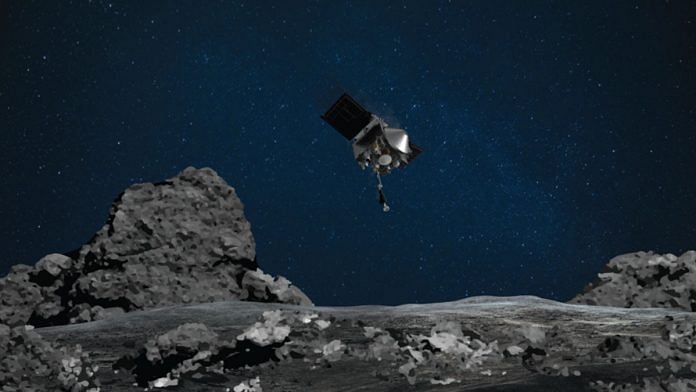New Delhi: In a first, NASA’s OSIRIS-REx spacecraft has successfully collected dust and pebbles from the surface of an ancient asteroid named Bennu — located 321 million km from the Earth — four years after it was launched from the US.
The Origins, Spectral Interpretation, Resource Identification, Security, Regolith Explorer (OSIRIS-REx) will return these samples to Earth in 2023.
The well-preserved and ancient asteroid, Bennu, is expected to provide scientists insight into the formation of the solar system, a billion years ago.
The back-away burn is complete ?✅ I'm now moving to a safe distance away from Bennu. pic.twitter.com/bXk2ufSneS
— NASA's OSIRIS-REx (@OSIRISREx) October 20, 2020
“This amazing first for NASA demonstrates how an incredible team from across the country came together and persevered through incredible challenges to expand the boundaries of knowledge,” NASA Administrator Jim Bridenstine said in a statement.
“Our industry, academic, and international partners have made it possible to hold a piece of the most ancient solar system in our hands,” Bridenstine said.
Also read: NASA is tracking a dent that’s slowly widening in Earth’s magnetic field
TAG manoeuvre to collect sample
To achieve this feat, at around 11.20 pm Tuesday night, OSIRIS-REx first moved out of orbit around Bennu.
Just before the spacecraft started its 805 meter journey towards the surface of the ancient asteroid, its 3.35-meter long robotic arm unfurled. The descent took four hours in total to complete.
When the spacecraft was hovering just 125 meters above the surface, it began the specific ‘Touch-and-Go’ (TAG) manoeuvre to precisely target the sample collection site, known as ‘Nightingale’.
Ten minutes later, the spacecraft began to slow its descent and match the asteroid’s rotation at the time of contact. In the next 11 minutes it cruised past a boulder the size of a two-story building, nicknamed ‘Mount Doom’, located in Bennu’s northern hemisphere, to touch down in a clear spot in a crater.
“This was an incredible feat – and today we’ve advanced both science and engineering and our prospects for future missions to study these mysterious ancient storytellers of the solar system,” said Thomas Zurbuchen, associate administrator for NASA’s Science Mission Directorate.
“A piece of primordial rock that has witnessed our solar system’s entire history may now be ready to come home for generations of scientific discovery, and we can’t wait to see what comes next,” Zurbuchen added.
The NASA team will now ascertain if Tuesday’s TAG event provided enough of a sample. The ideal sample size is 60 gm, roughly equivalent to a full-size candy bar.
If the sample is adequate, the scientists will command the spacecraft to begin its journey back to Earth in March next year. If not, another TAG event will be attempted in January.
The mission had been under planning for over a decade and the spacecraft was launched from Cape Canaveral Air Force Station in Florida, US, on 8 September 2016. It arrived at Bennu, almost two years later, on 3 December 2018.
It is scheduled to return to Earth on 24 September 2023.
Also read: NASA launches most complex mission ever to search for signs of life on Mars



